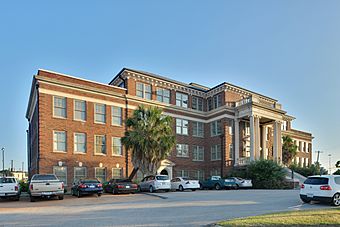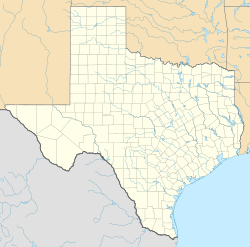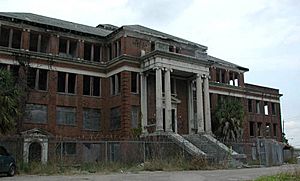Jefferson Davis Hospital facts for kids
Quick facts for kids |
|
|
Jefferson Davis Hospital
|
|

The renovated building in 2010
|
|
| Location | 1101 Elder St., Houston, Texas |
|---|---|
| Built | 1924 |
| Architect | W. A. Dowdy |
| Architectural style | Classical Revival |
| NRHP reference No. | 05000859 |
The Jefferson Davis Hospital was a very important hospital in Houston, Texas. It opened in 1925 and was the first main hospital to treat people who couldn't afford medical care. It closed in 1939.
This building is listed on the National Register of Historic Places, which means it's a special historic site. The Houston City Council also made it a protected landmark in 2013.
Today, the old hospital building is called the Elder Street Artists Lofts. Since 2005, it has been a place where artists can live and work.
Before the hospital was built, this land was a cemetery for the City of Houston. Thousands of people were buried there, including soldiers from the Confederate States Army, former slaves, and city officials. The cemetery was used from 1840 until the mid-1890s. Because it became run-down, the city decided to build a hospital there in the 1920s.
Some people believe the building is haunted because of its past as a cemetery.
Contents
Building Style and Design
The Jefferson Davis Hospital building was designed by Wilkes Alfred Dowdy, who was the architect for the City of Houston. It was built in a style called Classical Revival. This means it looked like grand buildings from ancient Greece and Rome.
Outside Look
The hospital was a four-story building made of red brick. It had a beautiful front with stone decorations and many large windows. The main entrance had a square porch with four tall, fancy columns. These columns and other stone details were typical of the Classical Revival style.
There are some square stone walls at the front of the building. People think these might have been old gravestones from the cemetery or perhaps flower beds. No one knows for sure.
The architect designed the building with high ceilings and lots of big windows. This allowed plenty of sunlight and fresh air to come in. This was important because it helped keep the hospital clean and was thought to help sick people feel better. The building was also placed on a high spot, which helped breezes flow through.
The second and third floors had two screened balconies. Patients could go out on these balconies to get fresh air without leaving the hospital.
Inside Look
While the outside was grand, the inside of the hospital was simple. This was because it was a charity hospital for people who couldn't pay. The floors were made of a special material called terrazzo.
There was even a children's garden and playground on the rooftop! This made the building more useful without making it bigger.
In 2005, the building was renovated by Artspace. They spent $6.3 million to restore it. They kept many of the original features, like the terrazzo floors, high ceilings, and large windows. They also added a "green" roof, which helps the environment.
History of the Building
Before the Hospital (1840–1924)
The land where the hospital stands was first used as a city cemetery starting in the 1840s. It replaced an even older cemetery. Over many years, thousands of people were buried there. This included over 6,000 Confederate soldiers, former slaves, and city officials. Many victims of yellow fever and cholera epidemics were also buried there.
The city stopped using the location as a cemetery in 1879, but families continued to bury loved ones there until the 1890s. By the early 1900s, the cemetery was in very bad shape. The city then decided to use the land for public health services instead.
Hospital Years (1924–1938)
In the early 1920s, the Houston City Council planned to build Jefferson Davis Hospital. Some people were worried that building the hospital would disturb the graves. When construction began in 1924, the basement was built above ground. This was done to try and avoid disturbing the graves. While some graves were moved, it was later found that many remains were still there.
The hospital was named after Jefferson Davis, who was the president of the Confederacy. This was done to honor the Confederate soldiers buried in the cemetery and to comfort their families.
The hospital opened in 1925. It was run by both the City of Houston and Harris County. However, it was only used as a main hospital for 13 years. By the late 1930s, Houston was growing fast, and the building became too small for all the people who needed care.
On January 1, 1938, the city's main medical services moved to a new location. The hospital officially closed its doors in 1939.
Other Uses (1938–1989)
After the hospital closed, the building was used for many different things. For a short time, it offered some medical services. Then, it became a place to store medical records. Later, it was used as a probation office, a home for young people, a clinic for certain diseases, and a place to get food stamps. It was also a drug treatment center and a storage facility for the county from the 1960s to the 1980s.
Because of its history, some people mistakenly thought the hospital was once a mental asylum. This was due to confusion with another facility called Jefferson Davis on Allen Parkway, which was a psychiatric treatment center.
The probation office next to the hospital was also rumored to be haunted. People reported strange noises, seeing a woman believed to be a nurse, and figures disappearing in the restroom. Police dogs even refused to enter the building once when a fire alarm went off!
Empty and Falling Apart (1989–2003)
For about two decades, from 1989 to 2005, the building was empty and slowly fell apart. A newspaper article from 2000 described it as being in very bad condition. Windows were broken, plaster was falling off the walls, and junk was everywhere. Weeds and even trees were growing inside.
Because of its spooky reputation, the building became a popular spot for young people to break into on Halloween night for thrills.
In 1995, the site was recognized as a State Archaeological Landmark. This was because of its past as a major cemetery.
Restoration and New Life (2002 to Present)
In 2002, the City of Houston decided to declare the building a city landmark. Later that year, Harris County approved selling the hospital to two groups, Avenue Community Development Corporation and ArtSpace Projects Inc. These groups promised to fix up the old building.
In 2003, a group of college students looking for ghosts at the building were robbed. Luckily, no one was hurt.
The big renovation project began in 2003 and cost $6.3 million. The goal was to turn the old hospital into 34 artist lofts and homes. This new space is now called the Elder Street Artist Lofts. Many organizations helped pay for the project, including the City of Houston and the United States Environmental Protection Agency. The EPA even gave money to clean up asbestos and lead.
Because the building was a historical landmark, the U.S. Department of the Interior and the Texas Historical Commission watched the renovation closely. They made sure the restoration was historically accurate. This meant keeping the original layout, plaster walls, and window frames. An archaeological survey was done before construction to make sure no graves were disturbed.
The renovation was finished in 2005. However, another part of the historic Jefferson Davis Hospital building was destroyed in a fire in 2013. Sadly, a firefighter was hurt in that fire.
A separate building, the nurse's quarters, was also built in the 1920s. It was damaged in a storm in 2017 and was later torn down.
Artist Lofts Today
After the renovation, the building was renamed the Elder Street Artists Lofts. It has 34 homes and studios. At first, only artists could live there, but now it's open to everyone. People in Houston loved the renovation. It even won an award for "Best Renovation" from the Houston Press in 2006.
The lofts are part of the Houston Independent School District (HISD). Children living there would go to Crockett Elementary School, Hogg Middle School, and Heights High School.
See also
- Six wards of Houston




